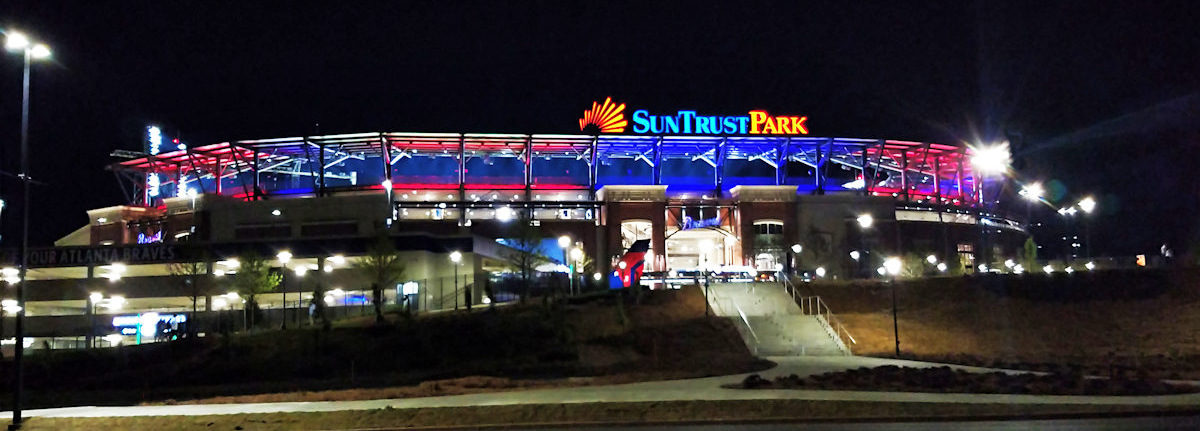Article by Joe Mock, BaseballParks.com
All photos by Joe Mock, except as indicated
All rights reserved
“I still have the renderings and graphics from 2005 for a 3.5-million-square-foot development around Turner Field,” recalls Mike Plant, the Atlanta Braves’ President for Development. He was talking about the team’s desire to develop the expanse of land that surrounded the team’s home stadium at the time. “We started that process because we recognized very early that there’s no reason for people to come to that site for anything other than 81 baseball games a year.”
| Ballpark Stats |
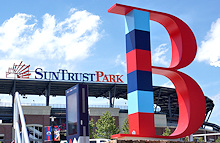 |
| Team: Atlanta Braves |
| First game: April 14, 2017, a 5-2 win over the Padres |
| Capacity: 41,149 |
| Dimensions: LF – 335; LCF – 385; CF – 400; RCF – 375; RF – 325 |
| Architect: Populous |
| Construction: American Builders 2017 (consortium of Mortenson, Barton Malow, Brasfield & Gorrie, New South) |
| Price: $672 million |
| Home dugout: 1B side |
| Field points: South by southeast |
| Playing surface: Seashore Paspalum — Platinum TE |
| Ticket info: www.braves.com/tickets or call 800-745-3000 |
| Betcha didn’t know: The metal canopy over the upper deck is the largest in the sport, measuring 108,000 square feet |
And rather than simply suggest to the City of Atlanta that they find someone to implement the development, the team was eager to take it on themselves. “The reason we had to be the ones to do it is because any time someone (else) puts something vertical outside of our front door, it’s going to have an adverse financial and operational impact on our business.” Besides, Plant pointed out that municipalities typically don’t pull off a project like this efficiently.
There were other factors, too. While City planners made a very logical decision in the 1960s to build Fulton County Stadium near the intersection of I-20 and I-75/85 on the edge of downtown Atlanta, that site (Turner Field was built adjacent to the stadium) had become less popular over the years due to growing traffic congestion. “Well, you know Atlanta,” chuckled John Schuerholz, the team’s Vice Chairman who was recently elected into the Baseball Hall of Fame. “Their traffic engineers probably didn’t win a lot of awards for deciding to bring two Interstate highways together through the center of this robust community.”
Another complication was that the Braves’ lease on Turner Field was due to expire at the end of 2016. The ballpark was going to need major upgrades, and the City appeared quite unexcited about the prospects of paying for them, especially after its major commitment to the new stadium for the NFL Falcons.
If the City had been more helpful in the team’s desire to develop the acreage around Turner Field, the team might’ve been more willing to partner with the City on renovations to the ballpark. The City of Atlanta, though, continued to be unwilling to allow the Braves to buy the land around the stadium so their development plans could proceed.
Schuerholz recalled that, “We sat at the negotiating table for a long time and we tried our best and we believe the City tried its best and they got to the point where they told us that there was no possibility that that was going to happen, that we weren’t going to be able to acquire that land. I’m not going to ascribe fault to anyone. It just didn’t work.”
All the while, the clock was running down on the time left in the lease on Turner Field. Plant recalled that in 2013, “I went home and told my wife, ‘Hey, we’re behind by six touchdowns at the half. We’ve got to figure out a new game plan.’“
So the Braves’ executives started exploring other sites that could accommodate a new baseball stadium as well as the kind of commercial development that they envisioned. They assessed a number of locations within the City as well as in the adjacent suburbs. And they kept that search under wraps.
A key event in the story occurred on July 3, 2013. Plant arranged a lunch with Tim Lee, the Chairman of the Commission of Cobb County, a suburban area with a number of affluent communities to the northwest of the City of Atlanta … and it was no coincidence that when the team plotted where their ticket buyers live, the scatter diagram showed enormous density in Cobb County.
“That lunch turned into a three-hour session,” Plant recalled. “I started telling him what our vision was, what we could bring to the table and how a basic structure would work. I made it clear we had to control the development.” The County would just have to supply part of the money for a new ballpark. That stadium “was going to be the crown jewel, and would have to be a public-private partnership. But we were going to own and operate and finance and build an entire mixed-use development that was obviously going to be the return on (the County’s) investment on the stadium.
“Fortunately, Tim was a visionary.”
The Braves made a short list of possible locations in the County, as did Lee. The one site on both of their lists was where the new park is today, near the intersection of I-75 and I-285. The framework of a deal was struck.
Since the Braves were going to supply the land for the stadium and development, they had to get busy buying up the necessary parcels. They also had to start the work of planning and designing the ambitious undertaking, all while keeping the project a secret.
| The players |
| You can’t have a baseball game without players, and you certainly can’t accomplish an undertaking as massive as SunTrust Park and The Battery Atlanta without the efforts of some key individuals. |
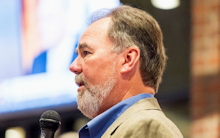 |
| Mike Plant (above) is the Braves’ President for Development. He was on the front lines in negotiating the arrangements to move to Cobb County — and in keeping the process confidential. (photo courtesy of the Braves) |
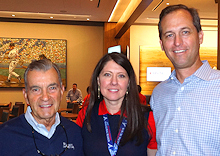 |
| Above is the Braves’ Vice Chairman John Schuerholz, Populous’ Mason Hansen and the team’s President for Business Derek Schiller. |
 |
| William (Bill) Rogers, Chairman and CEO of SunTrust Banks, facilitated a 25-year agreement with the Braves for the naming rights to the ballpark. |
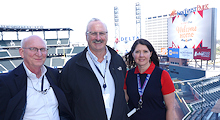 |
| Here are some of the key players from Populous who worked closely on SunTrust Park: Senior Architect/Principal Bradd Crowley; Managing Director Earl Santee; Senior Interior Designer/Principal Mason Hansen |
Much has been made about the hush-hush nature of this undertaking, and the fact that the County’s outlay of money toward the stadium’s construction wasn’t put to a public vote. (In brief, it wasn’t required, only a majority vote of the County Commissioners.) Keeping things a secret was all the more challenging because over 40 people – all of whom signed non-disclosure agreements (NDAs) – were brought in. They included engineers, architects, financial analysts and bonding experts, according to Plant.
“The important thing was that we weren’t going to negotiate this out in the open public,” he emphasized. “Some people like to use the word ‘secrecy’ a lot (about the process). We prefer the word ‘confidential.’ We wanted to keep things confidential until there was something to talk about.” And just like a trade of players, “we don’t like to air our business in the public ‘til we have something to say and can back it up with facts.”
Further, one assumes that if officials at the City of Atlanta had gotten wind of this, they wouldn’t have been keen on a Major League sports franchise leaving its borders. They could’ve attempted to undermine the project.
In addition, Kasim Reed, Atlanta’s mayor, was up for re-election during the fall of 2013. The Braves were determined to keep their impending move out of the newspapers because they didn’t want the citizens of Atlanta to vent their displeasure when placing their votes for mayor. Plant said that he wanted to wait to make the announcement “until the Mayor had been re-elected. I didn’t want this to be a distraction where people were saying ‘He lost the Atlanta Braves.’”
He added that another key reason behind the need to keep the negotiations under wraps was so the Braves could retain their ability to make the right deals quickly. “This entire project is one where you have to be decisive,” Plant explained. “You don’t finish what we did in 30 months without being decisive.”
With so many people involved in the ramp-up phase, keeping the project under wraps during the four-month process of pinning down land purchases and preparing plans was a challenge – and in fact, there were several times when the team feared that the word had gotten out.
One of the Braves’ political liaisons (who had signed an NDA) had a brother who owned a restaurant in Cobb County. In October, a month before the team intended to announce their move, Plant received a frantic call from the liaison. According Plant, he told him, “I think we’re done, man. A bread truck driver just walked into my brother’s restaurant and said, ‘Did you know the Braves are moving to Cobb?’”
Plant’s heart sank. “If a bread truck driver knew, then everyone’s about to know. I mean, how does a guy like that know?”
Further, with so many people working on the plans for the development and stadium, “We were afraid that one of them would have a friend in the media or in some way a rumor would explode on social media,” Plant recalled.
“But it never happened. We asked ourselves, ‘How could this be?’”
Word didn’t leak out, meaning the team could make the announcement on its own terms, rather than having to react to a viral outbreak of rumors. The Mayor was re-elected, and team officials then met with him to tell him of their plans. “It wasn’t a pleasant conversation, and the rest as they say is history.”
On November 13, 2013, the Braves announced they were moving to Cobb County following the end of their lease at Turner Field in 2016. All but a few dozen people were stunned to learn of this. I was certainly one of the stunned majority.
Not by a long shot is this the end of the story. Despite numerous financial advantages of having The Battery Atlanta (the name of the development adjacent to the ballpark) and SunTrust Park in their County, voters tossed Tim Lee out of office on July 26, 2016. The Atlanta Journal Constitution called the election “a litmus test for support of the deal to bring the Atlanta Braves to Cobb.” Indeed, challenger Mike Boyce based his entire campaign on the assertion that the Braves deal should’ve been put to voters.
| Before the bulldozers |
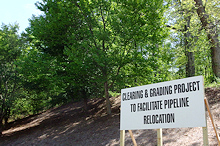 |
| Several months after the surprising news broke that the Braves were moving, I examined the site that would be their new home. The shot above shows that preliminary work had begun to move the underground pipelines. |
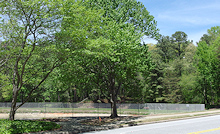 |
| This shot is on the southern side of the property. The pond had already been drained and its turtles moved. Today, this would be looking at the back of the ballpark’s outfield. |
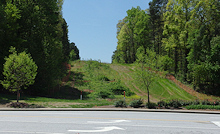 |
| This is from the eastern end of the site. It shows the easement for the pipelines prior to their relocation. Today this same hill remains, with the Third Base Gate for the park at the top of the embankment. In fact, the nighttime photo at the top of this page was taken from this same vantage point. |
Part of the narrative used by opponents to the plan was that public funds that helped build the new stadium were secretly stolen from other needy projects. “You can use this as a platform against a politician, saying ‘You took my money,’ without ever understanding the return you’re getting,” said Plant. “Half the people who voted against Tim swore we were stealing money from the kids, that we raided the school board’s bucket to pay for this.”
Plant explains the finances this way. Prior to the Braves buying and developing this 57 acres of land, the property generated $305,000 a year in taxes to the County. “Next year, it will put $28 million in sales tax and property tax into the County and State coffers, and it will just go up from there.”
And as for the assertion about raiding the school board’s budget to build a stadium? “The superintendent of public schools, Chris Ragsdale, sent out a press release that said, ‘I want everyone to understand that over the next 10 years, the Atlanta Braves are putting $120 million in the school board’s bucket.’ Hey, that is not robbing money from the kids.”
And there’s been controversy over exactly how much the County is spending on the stadium. “I’ve seen it in print twice in the last two days (that) it’s $400 million in public money. Wrong. Completely wrong. It is $276 million.” Plant explained that since the Braves are spending $181 million over 30 years in helping to pay off the County’s bonds on the project, that’s money the County doesn’t have to spend.
In other words, the County’s net outlay of $276 million is generating a “return on investment” of about 10% in the next year ($28 million in increased tax revenue) and more than that as revenues in The Battery continue to grow – all the more impressive when you consider this undeveloped land was previously generating just $305,000 in taxes each year.
And in case you’re wondering, Plant says that the total amount of money being spent by the Braves on The Battery Atlanta and their share of the stadium costs is $1.1 billion.
Another controversy popped up over whether the team would still be called the Atlanta Braves once they moved out of Atlanta. Schuerholz put that to rest by explaining that the “beautiful stretch of land in Cobb County is (only) about ten miles north as the crow flies from Turner Field, so it’s not as if we moved to Timbuktu. We made it clear that we will still be the Atlanta Braves, we will have the ‘A’ on our hat (and) ‘Atlanta’ proudly across our chest.”
Further, while many in the metro area say that the team’s new home is in the Cobb County city of Smyrna, that’s not technically true. The site is in zip code 30339, which is in Atlanta, but just not within its city limits.
An important part of the story of SunTrust Park is the team’s partnership with, of course, SunTrust Bank, which entered into a naming-rights and promotional agreement with the team for 25 years. “You don’t lend your brand to just anybody,” William Rogers, Chairman and CEO of SunTrust Banks, Inc., told Baseballparks.com. “We see the Braves as having shared values with SunTrust. We think they are an iconic brand and we think we are an iconic brand. They’re the hometown team and we’re the hometown bank.”
While the financial side of the contract isn’t public, SunTrust customers will enjoy the presence of a bank branch within The Battery, as well as ATMs within the ballpark. More importantly to SunTrust, just a block from the entry gates is the onUp Experience, where “clients and fans can interact with us in unique ways,” says Rogers. In addition to interactive games and Braves trivia contests, visitors learn about SunTrust’s purpose, which is helping people find financial well-being.
So the details of SunTrust Park and The Battery Atlanta which adjoins it are no longer under wraps, as the Braves are indeed playing games in Cobb County. What is the ballpark like? Was it worth all the planning and expense? Read on as we look more closely.
The Setting
So where is this brand-new stadium, and how in the world was the land available for the Braves to purchase and develop?
First, SunTrust Park is not hard to find. Perched high on a hill, it’s visible clearly from I-75 and I-285, northwest of downtown Atlanta. In fact, the park is in the northwest quadrant of the interchange for those two major thoroughfares.
A criticism of the park’s location has been that it’s hard to get to, because you have to drive on some surface streets once you exit whichever Interstate you’ve taken to get there. Honestly, I don’t think the stadium could be in a more logical place. True, these are really congested highways, but the Braves have gone to great lengths to partner with Uber and Waze to ease things, plus game times are later on weekdays to allow commuter traffic to lessen.
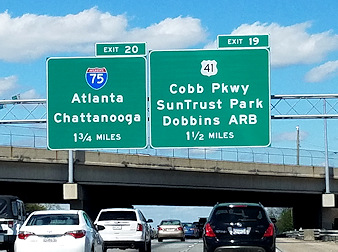  |
| Even before the Braves’ first games at the new park, signs on I-75 and I-285 directed fans to the proper exits. On the right is the view from I-75, just north of its interchange with I-285. Yes, the park acts as its own billboard, especially at night. |
In addition, there are overpasses and additional lanes currently under construction that will give extra options for exiting the Interstates, plus a pedestrian bridge over I-285 just opened that permits fans to park at the Galleria shopping area and walk to the park.
But why was this site – virtually adjacent to the intersection of two of the most used highways in the region — available to be purchased and developed by the Braves?
Simple: no one wanted to develop the land because three major underground pipelines ran diagonally through the property. “It was zoned for commercial development, but those pipelines were an inhibiting factor,” Plant explained.
Undaunted, the Braves (during the period of secrecy) grabbed the bull by the horns. Plant asked to meet with the CEOs of the two companies who owned the pipelines. “They signed NDAs so I disclosed our plans (by) showing them some renderings. They fell off their chairs, then got back up on their chairs,” he chuckled.
One of the two companies was Colonial Pipeline. According to Plant, “Their CEO said, ‘Huh, I guess my pipelines go right through the middle of that property, and I guess you’d like for me to move ‘em.’ I said ‘Yes, it would be great if you could.’ He said, ‘We can do that. You’d just have to pay for it.’”
The other CEO (of Atlanta Gas) had the same reaction. So the arduous process of re-routing the pipelines began. Preparing the site for the commencement of construction had to wait until that was done.
The 57-acre site had a pond which, interestingly, is not far from the current spot of SunTrust Park’s water feature in center field. The pond presented a challenge, though, because of its turtle population. Naturally, the Braves turned the challenge into a PR opportunity, and invited local Boy Scouts to help retrieve the turtles (which, interestingly, weren’t native to the area) and move them to another appropriate environment.
Site planning had already been completed at that point. It called for the park to be at the eastern end of the property. But wouldn’t it have made more sense for it to be the “centerpiece” of the commercial development instead of east of it?
“We actually had a long, long debate over the location of the ballpark on the site,” Braves’ President of Business, Derek Schiller, told me. “We really had two choices: putting the ballpark to one side of the development or putting it right in the middle.” He explained that two factors ended up determining the placement of the park. First, the relocated pipelines now run along the southern edge of the property, and an 80-foot-wide easement above the pipelines can’t contain any construction. This also partially explains why the ballpark’s outfield is open to the south, instead of a more typical orientation toward the northeast.
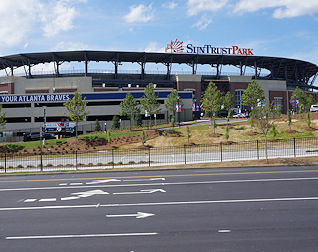 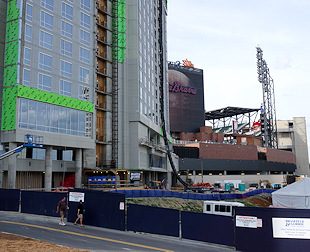 |
| The shot on the left, taken from Circle 75 Parkway southeast of the park, shows the significant slope of the site. The vantage point on the right is the downhill side of the site, beyond the ballpark’s center field, where the pond once existed. The building under construction is the Omni Hotel. No turtles in sight. |
Second, the topography of the parcel of land was decidedly lopsided, with a grade change of about 70 feet from north to south. “Instead of trying to push all that dirt around and make it level, we embraced that and took advantage of that,” Schiller said. “So one of the great architectural aspects of this ballpark is that it is built into the side of a hill (so) when you arrive at the first-base or third-base entrances, you enter at grade. You then walk down to the main concourse and further down to the seating. It’s very dramatic.”
But what about the effect this had on the commercial development? “We determined it would be very difficult to operate a development that was in effect dissected by a ballpark. In effect, you’d have two developments.” Not what the Braves wanted.
A great deal of planning went into the precise way the commercial area intersects with the ballpark – which is beyond right field. “The meeting point is The Plaza,” Schiller pointed out. “The Plaza represents the area that can be activated for game days in very unique ways, and non-game days can be just as active. It was a challenge. A big challenge.”
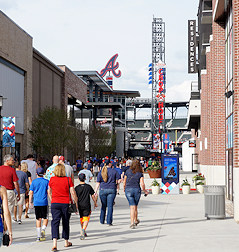 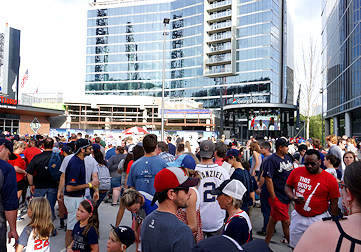 |
| Fans head from parking garages and the pedestrian bridge across I-285 through The Battery’s stores and eateries. On the right, The Plaza is quite “activated” (as the Braves like to say) with pre-game merriment. The Omni Hotel is in the background while the ballpark is to the left. |
But they pulled it off. As fans milled around in that Plaza during the first weekend of games, it was obvious that the area was “activated.”
Surrounding that Plaza is quite a variety of activities and eateries. A grassy oval spreads out in front of a concert shell. A splash pad is a magnet for kids. The Fox Sports South/Southeast pregame show is broadcast from there. Braves personalities conduct contests and games for fans waiting to enter the gates.
A number of bars and restaurants beckon, but the biggest draw of them all is Live! At The Battery Atlanta, a multimedia feast for the eyes and ears. Not only does it have the most prime position in The Plaza (directly opposite the right-field gates of the park), it benefits from being operated by Cordish, the company behind the brilliant Ballpark Village in St. Louis. Indeed, it follows its blueprint of gargantuan-screen TVs, blaring music, hosts acting as pep-rally leaders and two levels of food and drink. It also encompasses the Todd English Tavern and the Sport & Social Club, and will shortly include PBR Bar & Grill. It is awesome to behold.
But that’s not all that’s in The Battery. The Coca-Cola Roxy concert venue is just a few feet away, as is the aforementioned SunTrust Bank’s onUp Experience. There’s even a Harley-Davidson store just steps away.
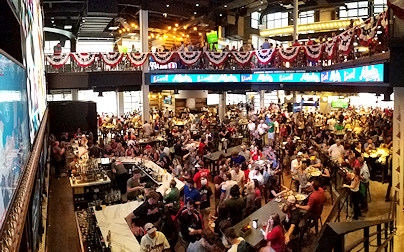 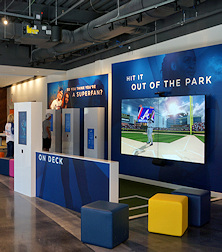 |
| The interior of Live! At The Battery Atlanta is electric, just like its counterpart at The Ballpark Village in St. Louis. The SunTrust onUp Experience Center (right) is not a bank branch. Far from it, as it features an interactive video game, Braves trivia and more. |
By my count, when all of the establishments are operational, there will be 17 eating/drinking establishments in The Battery. That doesn’t include all of the office space, entertainment venues, shops, condos, apartments … and in early 2018, an Omni Hotel just beyond left center field.
Again, it boggles the mind what is adjacent to SunTrust Field. And none of it existed a few short months ago.
There are several large parking garages that are part of the development, plus the parking decks of the already-existing office buildings across the street are used for game parking. Still, when there is a crowd of 40,000-plus, it would be gridlock if drivers are wandering around aimlessly looking for an available lot. That’s why fans are urged to use Uber or park across I-285 at the Galleria and walk across the new pedestrian bridge. There are also lots on the east side of I-75, and (of course) there’s a new pedestrian walkway there, too.
The Exterior
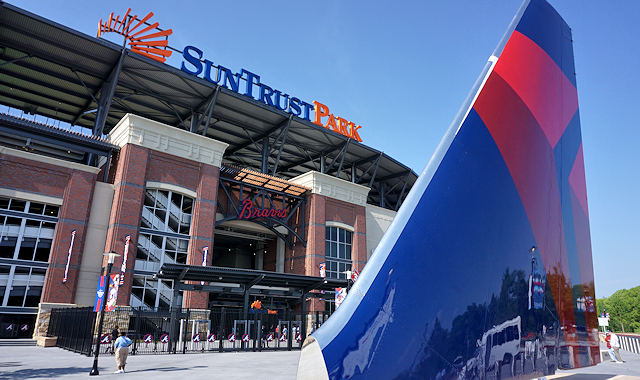
Populous is the architecture firm behind SunTrust Park. More on them in a moment, but Schiller made an interesting observation about them. “When fans walk up to one of their ballparks, (Populous) wants it to look like it is very substantial. They want you to walk up to it and say ‘Oh my gosh! This is a big building! It’s oversized, larger than life.’” But that approach wasn’t what the Braves desired at all. “We didn’t want to make the mixed-use architecture look disjointed, so a lot of what we spent time on was minimizing the feel, the sizing and the scaling of the ballpark.” In other words, the stadium shouldn’t dwarf The Battery.
There’s no denying that SunTrust Park is a large structure. In fact, it encompasses 1.1 million square feet. That’s hard to hide.
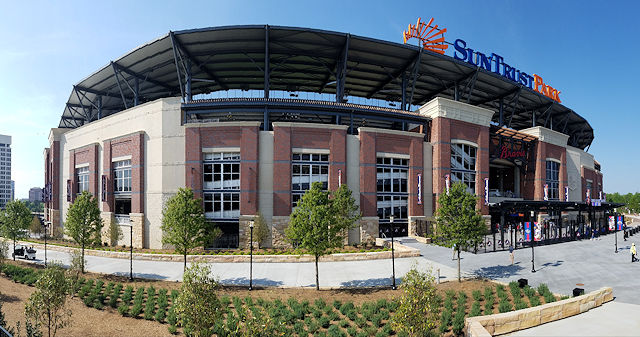
So what did they do to make the stadium’s exterior harmonious with The Battery? As you talk to various Braves officials, you’ll hear the words “classic,” “timeless” and “authentic” used repeatedly to describe the park’s exterior. Says Schiller, “We didn’t want it to be built in the era of today, and then in 20 years the architecture world changes and it feels out of date.”
He points out that one of the keys is the use of brick. By using masonry that resembles patterns popular in the Southeast for generations, it gives the ballpark’s exterior a look of “timelessness.”
In addition, they decided to use pre-cast stone. “It looks custom hand-laid. It’s at all of the entryways. It brings the whole scale of the brick way down.” In addition, by designing breaks in the masonry like porches, canopies, varying angles and trellises, “it not only creates shade, it also warms the architecture and gives it a different scale.” This is especially true on the side of the ballpark closest to The Battery Atlanta.
 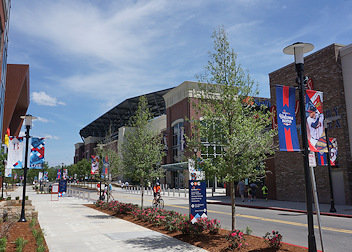 |
| The Third Base Gate is shown on the left. The construction techniques described by Schiller are evident. On the right is the junction point between The Battery Atlanta (on the extreme right) and the ballpark (center of photo). |
Earl Santee, Managing Director of Populous, told me that his team “was very involved with the master planners of the development. The integration of this building (the ballpark) with those other buildings was really crucial to the success of the project.” The result was “a fully integrated experience that’s never been seen in baseball before.”
Seemingly flying in the face of the desire to reduce the scale of the exterior is the canopy that covers most of the park’s upper deck. Not only is it the largest of any baseball park, it is surprisingly high above the top row of seats. Santee explained that not only did it give the park’s silhouette a distinctive look, but it also significantly enhanced airflow within the seating bowl. If you’ve ever visited Atlanta in August, you’ll understand.
As Schiller pointed out, the entryways weren’t meant to look imposing. They are, though, a fascinating combination of masonry patterns with concrete panels mixed in. The Left Field Gate is probably the most impressive, possibly because it is on the downhill side of the property. The least imposing is the Right Field Gate, which makes sense because it is across the sidewalk from the Live! complex of clubs. Remember, the Braves don’t want the ballpark’s exterior to compete with the look of The Battery.
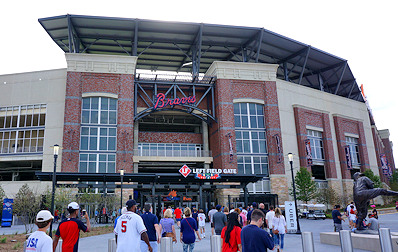 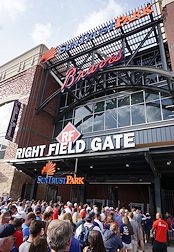 |
| The entryway on the downhill side of the park is the most elaborate. Here you’ll also find the statue of Warren Spahn (far right in the photo). The Right Field Gate is the one closest to The Battery. |
Most ballparks have an entryway behind home plate, which is natural because many parks are bounded by streets that intersect in right angles. They often have a gate at each corner, with the main gate being behind home. At SunTrust Park, this is not the case. Instead, the area within the park directly behind home is where the Monument Garden is located (more on that in the next section), so there’s no entryway there at all.
Without a doubt, the most unusual entry to the ballpark isn’t even on street level. That’s because there is a pedestrian bridge high above The Plaza that leads to the upper level of the Terrapin Taproom and the roof of the Chop House. Yes, there are metal detectors and ticket takers there.
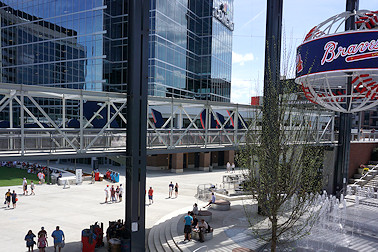 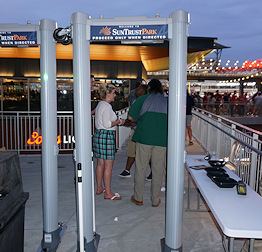 |
| The elevated walkway on the left certainly presents fans with a unique way of getting into the ballpark. The security gate for this catwalk is shown on the right, with the top level of the Chop House beyond. |
And while there is a 360-degree concourse on the park’s interior, the same can’t be said of the exterior. If you want to walk all the way around the outside of the stadium to see all of its exterior features — including the statues of Warren Spahn, Phil Niekro and the recently unveiled Bobby Cox — keep in mind that when you get to the area beyond center field, your trek will be blocked by the construction of the Omni Hotel.
So let’s venture inside and see what SunTrust Park’s interior is like.
